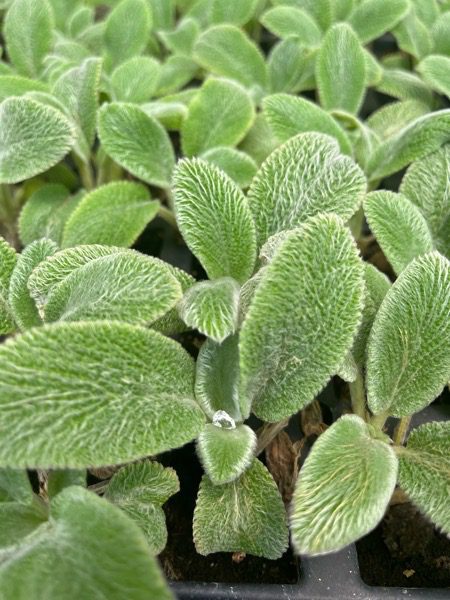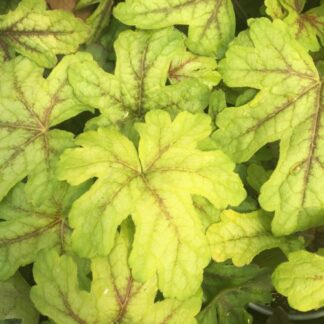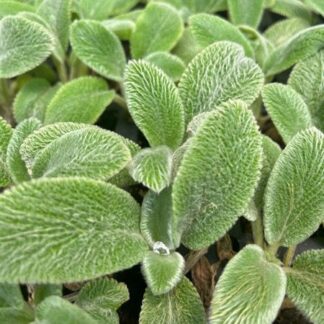Description
Lamb’s Ear: The Silvery Wonder Your Garden Will Love
Have you ever touched a plant that felt as soft as a lamb’s ear?
That’s not just a poetic description—it’s the real name of one of the most charming and low-maintenance plants you can grow: Lamb’s Ear, or Stachys byzantina. With its velvety leaves and silvery sheen, this plant isn’t just a feast for the eyes—it’s also a joy to touch, easy to care for, and surprisingly versatile.
Whether you’re designing a peaceful pathway, a playful children’s garden, or a hardy rock garden, Lamb’s Ear brings something special to the space.
Let’s take a closer look at why Stachys byzantina deserves a home in your garden—and how you can help it thrive.
Meet the Plant: What Is Lamb’s Ear?
Lamb’s Ear is a perennial herbaceous plant, which means it grows back year after year. It’s known for its thick, soft leaves that look and feel like—you guessed it—a lamb’s ear.
The foliage is silvery-gray and a little fuzzy. This gives your garden a calming, silvery glow that plays beautifully with sunlight and contrasts well with brighter greens, deep purples, or even fiery reds.
Native to the Middle East and parts of Asia, this plant has adapted to thrive in dry, sunny places. That makes it an ideal choice for modern gardeners who want beauty without the fuss.
Why Gardeners Love Lamb’s Ear
There’s so much to love about this plant. It’s not just about how it looks—it’s about how easy it is to grow, how little water it needs, and how much charm it brings.
Let’s go over the standout features:
1. Soft, Velvety Leaves
The foliage is thick and woolly, like soft felt. This texture adds a unique element to your garden, especially when planted near bold or shiny-leaved plants. It’s a plant people love to reach out and touch—kids especially!
2. Compact but Spreading Growth
Lamb’s Ear stays close to the ground, growing around 6 to 12 inches tall. But it can spread out 18 to 24 inches wide, forming a dense, cushiony mat. This makes it perfect for ground cover or edging.
3. Beautiful Blooms
In late spring to early summer, upright spikes appear with tiny, pinkish-purple flowers. These flowers attract bees, butterflies, and other pollinators. You can keep the flowers for the wildlife, or trim them if you prefer a neat, foliage-only look.
4. Drought Tolerance
Once established, Lamb’s Ear handles drought like a pro. In fact, it prefers things on the dry side. That makes it ideal for water-wise gardens or places with dry summers.
5. Cold-Hardy
This plant is hardy in USDA zones 4 through 8, which means it can handle both hot summers and chilly winters. Just give it well-draining soil, and it’s good to go.
6. Great for Sensory and Pollinator Gardens
Its soft leaves make it a wonderful plant for children’s gardens or sensory experiences. And its flowers support pollinators, adding life and movement to your space.
Where to Use Lamb’s Ear in the Garden
Lamb’s Ear isn’t just a pretty face. It’s also one of the most adaptable plants you can grow.
Here are some of the best places to use it:
🌿 Ground Cover
The way Lamb’s Ear spreads makes it a perfect low-growing carpet. It suppresses weeds, retains moisture, and creates a neat, silvery layer that softens the landscape.
🌸 Borders and Edging
Line your garden beds or walkways with Lamb’s Ear for a tidy, gentle look. The soft leaves spill slightly over the edge, making borders look natural and inviting.
🪨 Rock Gardens
Dry, rocky spots are where Lamb’s Ear shines. Pair it with sedums, agave, or ornamental grasses for a textured, drought-tolerant display.
🐝 Pollinator Gardens
The tiny pink flowers bring in bees and butterflies. Even though the flowers are small, they pack a punch when it comes to attracting wildlife.
👶 Children’s Gardens
Want a plant kids can safely touch and enjoy? Lamb’s Ear is a sensory delight. Just remind them not to pull too hard on the leaves!
Growing Lamb’s Ear: Step-by-Step
You don’t need a green thumb to grow Lamb’s Ear. But a little know-how goes a long way. Here’s what you need to keep this soft gem happy.
☀️ Light Needs
-
Full Sun: Lamb’s Ear loves sunlight. Six to eight hours a day is perfect.
-
Partial Shade: It can handle some shade, especially in hot climates. But too much shade can make it look floppy or dull.
🪨 Soil Preferences
-
Well-Draining Soil Is a Must: Lamb’s Ear hates soggy feet. Sandy, loamy, or gritty soil is best.
-
pH Range: Neutral to slightly alkaline (around 6.0 to 7.5).
💧 Watering Tips
-
Go Easy on the Water: Once it’s established, let the soil dry out between waterings.
-
Avoid Wet Leaves: Wet leaves can get moldy or mildewed. Water at the base instead.
🌡️ Climate and Temperature
-
Hardy in Zones 4–8: It handles most North American climates well.
-
Humidity Warning: In hot, humid climates, it may struggle. Choose drier spots and give it plenty of airflow.
🍂 Fertilizer Needs
-
Minimal Feeding Required: A bit of compost in spring is plenty.
-
Avoid Rich Soil: Too many nutrients can make it grow tall and floppy.
✂️ Pruning and Care
-
Tidy Up: Trim dead or soggy leaves as needed to keep the plant looking fresh.
-
Flower Spike Choices: Want just the leaves? Cut off flower spikes. Want to feed pollinators? Let them bloom!
-
Winter Cleanup: In fall, cut back the foliage if it’s messy. New growth returns in spring.
Propagating Lamb’s Ear
Lamb’s Ear is easy to share with friends—or use to fill in more spots in your garden.
Here are two easy methods:
1. Division
-
In spring or fall, dig up a mature plant.
-
Gently pull it into sections, each with some roots.
-
Replant the divisions in sunny, well-drained soil.
2. Cuttings
-
Take a stem cutting in spring or summer.
-
Plant it in moist, well-draining soil.
-
Keep it in partial shade until it roots—about 2–3 weeks.
Troubleshooting Tips
Lamb’s Ear is tough, but a few issues can pop up.
😟 Overwatering
-
Signs: Yellow, mushy leaves or rotting stems.
-
Solution: Improve drainage and water less often.
🦠 Powdery Mildew
-
Cause: Humid air and wet leaves.
-
Fix: Trim for airflow, water only at the base, and remove infected leaves.
🌱 Leggy Growth
-
Cause: Too much shade or rich soil.
-
Fix: Move to a sunnier spot and hold off on fertilizer.
🐛 Pests
-
Rare, but aphids or spider mites may appear.
-
Spray with insecticidal soap or neem oil if needed.
Seasonal Care Guide
Let’s break it down by season:
🌱 Spring
-
Remove winter debris.
-
Divide and replant if needed.
-
Add compost if you like.
🌞 Summer
-
Watch for mildew in humid weather.
-
Water only when very dry.
-
Trim flowers or enjoy them!
🍁 Fall
-
Reduce watering.
-
Trim off messy leaves if they bother you.
-
Let the plant prepare for dormancy.
❄️ Winter
-
Leave foliage if you like a natural look—or trim back for a tidy bed.
-
In snowy zones, trim leaves to prevent damage from heavy snow.
Design Tips and Companion Ideas
Lamb’s Ear plays well with others—especially in artistic garden designs.
🧶 Soften Hard Spaces
Use Lamb’s Ear to soften edges along sidewalks, patios, or driveways. Its soft texture invites you to pause and touch.
🎨 Add Contrast
Try pairing it with:
-
Purple Coneflower (Echinacea) for a bold color contrast
-
Russian Sage or Salvia for a purple-and-silver look
-
Black-eyed Susan for a sunny, cheerful mix
🧒 Make It Fun for Kids
Use it in children’s gardens with sensory features. Add plants like lamb’s ear, mint, lemon balm, and lavender for a multi-sensory experience.
🪴 Container Ideas
In pots, Lamb’s Ear adds texture beneath taller plants. Combine it with ornamental grasses, trailing sedum, or flowering herbs.
Why Lamb’s Ear Is Worth Growing
Let’s wrap up with what makes Lamb’s Ear such a standout:
-
It’s soft and beautiful, with year-round appeal.
-
It’s easy to grow, even for beginners.
-
It’s low water, low fuss, and high charm.
-
It plays well in many garden styles—from modern to cottage, rock to wild.
-
It brings in pollinators and delights kids and grownups alike.
In other words, Lamb’s Ear isn’t just another plant—it’s an experience. It invites you to touch, to feel, to pause. And it keeps your garden looking lovely with hardly any effort.
So if you’re dreaming of a garden that feels peaceful, looks polished, and doesn’t need daily attention… Lamb’s Ear might just be your perfect match.





